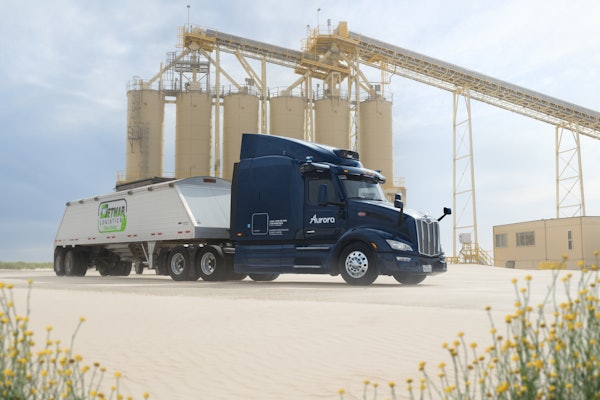Distracted driving is one of the biggest causes of crashes on America’s highways and resulted in more than 3,300 fatalities and countless injuries in 2022, according to National Highway Traffic Safety Administration data.
A recent survey of commercial vehicle drivers by Samsara looks into the causes of distracted driving and what can be done about it.
Contents of this video
00:00 10-44 intro
00:18 Distracted driving
00:43 Samsara’s survey of commercial vehicle drivers
02:17 What’s distracting drivers?
02:48 Truck drivers and AI dashcams
03:57 Opposition to driver-facing cameras
05:25 Three tips to get driver buy-in on in-cab tech
Matt Cole:
What's causing distracted driving and what can be done to cut down on it?
Jason Cannon:
You're watching CCJ's 10-44, a weekly episode that brings you the latest trucking industry news and updates from the editors of CCJ. Don't forget to subscribe and hit the bell for notification so you'll never miss an installment of 10-44.
Hey everybody, welcome back. I'm Jason Cannon and my cohost is Matt Cole. Distracted driving is one of the biggest causes of crashes on America's highways and it's resulted in more than 3,300 fatalities and countless injuries in 2022. Now that's according to National Highway Traffic Safety Administration data.
Matt Cole:
A recent survey of commercial vehicle drivers by Samsara looks into the causes of distracted driving and what can be done about it.
Evan Welbourne:
So our state of connected operations report this year really focused on drivers. So to produce that report, we interviewed 1500 drivers across 21 industries and seven countries comprising about 15,000 years of experience. And they told us firsthand about all their experiences with distracted driving and how they've worked to stop it. Key points included the first, the fact that distracted driving essentially affects everybody. 93% of the drivers interviewed reported that there was some significant impact from distracted driving at some point in their career, and that could be something like vehicle damage, personal injury, fines, loss of life, so really pretty significant impact for drivers. And then of those same folks, 79% reported even within the last year, they had had some close call or near miss due to distracted driving. So really top of mind for these folks. The second key point I would say is about driver retention.
That drivers really want proactive safety solutions to things like distracted driving. They want to work for companies that have a strong safety culture. I think we found that 90% said that they're more likely to stay with companies that are proactively working to address issues like distracted driving. And then the last key point I'd mention is that drivers really accept AI and supportive technology as a means for combating problems with distracted driving. And really at the top of the list we're accurate AI powered detection systems that kind of help them stop directed driving. So drivers are really leaning in with latest technology similar to their employers.
Jason Cannon:
Part of Samsara survey looked at what is actually distracting drivers while they're behind the wheel.
Evan Welbourne:
The top distractions vary by country, but if you look globally, you see about what you'd expect. You really at the top of the list is using the mobile phone while you're driving, either for texting or exchanging messages on social media, maybe for making a call. Also right up there is smoking or vaping that's more common in some countries than others. And then other things like eating and drinking are also common, but definitely using the mobile phone is right at the top of the list.
Matt Cole:
As Evan mentioned, surveyed drivers are beginning to accept AI as a way to combat distracted driving, but how can it help?
Evan Welbourne:
So AI dash cams help in a few ways. The first is with real time alerts. These are alerts that recognize distraction in the moment and they can help drivers just adjust, get their eyes back on the road with an audible ding or a voice reminder that they've got to refocus. The second way that they can help is just with support for coaching and training. So when it comes time to coach on a repeated risk behavior, they can really focus on recorded video of specific behaviors that that driver has exhibited. And so it's a lot more personalized. It's a lot more specific on coaching and more streamlined. It's better experienced for everybody, it's more effective. And then third, I'd mentioned AI dash cams are also about positive reinforcement. So videos also capture the good driving behaviors. They'll show improvement over time. They'll show things like defensive driving, and that's something we also saw in our stated of connected operations report that 82% of drivers preferred positive reinforcement to the more punitive measures. They said that they were much more effective
Jason Cannon:
While truck drivers have generally been opposed to driver facing cameras and AI in general, Evan says that started to change.
Evan Welbourne:
We've definitely seen an evolution in those viewpoints. We've seen partly there's this recognition that accidents don't just cost money. They can end your career. They can of course even cost lives. So drivers really like anything that's going to help them avoid an accident and stay safer. Another key point on that note is that both drivers and unions really want that video because it can exonerate them from fault in case of an accident. So we often see a case where the driver's doing everything right, they're driving and then there's an accident. They did everything they were supposed to do, but they still get blamed for it, right? And so it's incredible. We've seen many cases where if you review the video of the driver and of the road at the time of the accident, it becomes clear just within a few seconds that it was not the driver's fault.
They were doing everything they were supposed to. And that helps the employer avoid a potentially really costly verdict. It also helps protect the driver. It protects their career and their livelihood. And so that's another big attraction for drivers. The other thing that is clear with companies like Samsara is that we offer a lot of privacy controls. So these are controls on who can actually see video and when. And then there's capabilities we have like Inca nudges, which are just alerts that play in the cab for the driver. There's no video captured or uploaded, it's just to kind of help the driver in the moment. And that's something that drivers like as well as kind of a privacy preserving feature
Matt Cole:
For fleets struggling to get buy-in from their drivers on Inca Tech. Evan offers some tips.
Evan Welbourne:
So we think there's kind of three parts to getting driver buy-in, and really the foundation is clear and transparent communication with drivers, it's about their safety. You want to be specific about how the dash cams work, what data is collected, what kind of privacy controls there are for the drivers, and you want to encourage an open dialogue about that. You want to answer questions, create a forum for discussion, just make sure people are informed about this technology. The second thing is really highlighting the benefits to the driver. Again, you want to emphasize that it's super important to be able to exonerate the driver from fault using video when the time comes. If that happens, it's super beneficial to the drivers. And then you want to talk about how coaching is more personalized, it's more focused, it's more effective, streamlined, it's a lot better experience for the drivers.
And then you want to show some examples of how cams have really helped drivers in the industry. There's a lot of cases where drivers have benefited from AI dash cam technology, and you can give them a few examples. And then lastly, I think it's important to emphasize that positive reinforcement, it's not just about exoneration and better safety. You can get recognized for your good driving habits has never really been possible before. I mean, your driver can see how safe you are on the road and recognize or reward you from that. And again, we found 82% of the drivers we interviewed said that that positive reinforcement is really the most effective thing for improving their safety.
Jason Cannon:
That's it for this week's 10-44. You can read more on ccjdigital.com. While you're there, sign up for our newsletter and stay up to date on the latest in trucking industry news and trends. If you have any questions or feedback, please let us know in the comments below. Don't forget to subscribe and hit the bell for notifications so you can catch us again next week.











